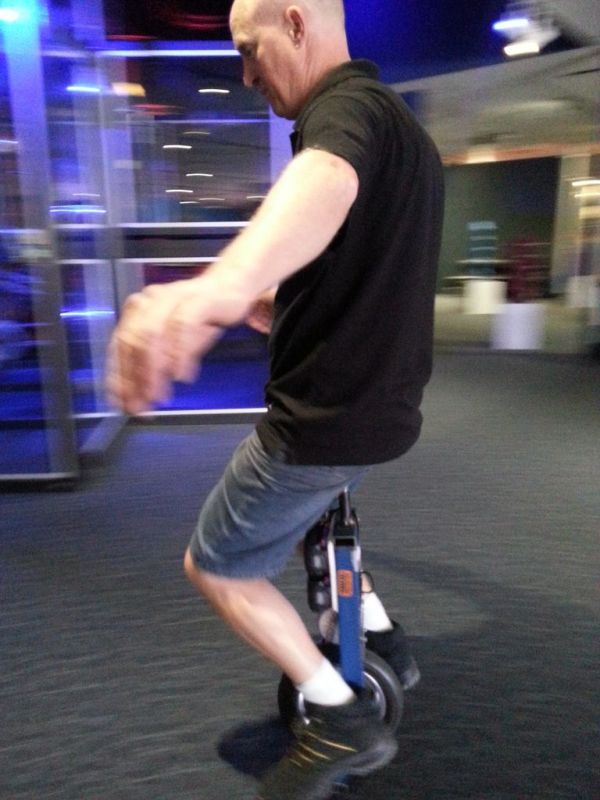Following the popularity of our self balancing scooter and the SciChair we decided to try something a little edgier, the Self Balancing Unicycle.
This project reuses a lot of stuff from our previous projects, using an arduino as the brains behind the scenes.
Step 1: Ready your tools
Before we begin lets ensure we have everything we need. For this project you probably want to be fairly comfortable with welding as you need to build a rigid frame.
[box color=”#985D00″ bg=”#FFF8CB” font=”verdana” fontsize=”14 ” radius=”20 ” border=”#985D12″ float=”right” head=”Major Components in Project” headbg=”#FFEB70″ headcolor=”#985D00″]
Additionally you will need:
•Steel square tubing for frame
•24VDC 300W motor
•Arduino UNO – Check your local suppliers or eBay.
•Sabertooth 2×25 Motor Controller ( www.dimensionengineering.com or a local supplier)
•5 DoF analogue IMU – available on ebay (to be replaced with digital IMU at some point)
•Scooter wheel, sprocket, chain and axle – available as a kit
•Batteries
•Shielded multi core cable for the accelerometer and heavy power cable for the motors
•Deadman switch
•Toggle switch for adjusting balance position.
•DC connector for Arduino.
•DIL pins to suit Arduino
•Double sides tape
•Screws etc
•Drill and drill bits
•Welding equipment and saftey gear
•Soldering iron and solder
•Wire cutter and wire strippers
•Heat shrink and hot air gun to shrink it [/box]
Step 2: Frame and motor
The seat is sourced from a second hand unicycle as we are lucky enough to work in an office where you can rely on someone having a unicycle they don’t ride much anymore. The shape of the seat is important as you need to be able to shift your centre of gravity forward and backward on the seat, something more difficult on a regular bicycle seat. We attached it to the frame with a simple steel pipe, nut and star hand knob tightening screw.
The wheel, sprocket, chain, and axle all came in a kit designed for a scooter.
We used 25x50mm tubing for the frame and 25mm for the foot pegs. A couple of plates across the middle of the frame served to mount the single motor with a piece of acrylic to which we glued or screwed the electronics.
The axle was set in a channel which allows the two sprockets of the motor and wheel to be moved so the chain can be easily fitted. A bolt above the axle stops it from suddenly sliding upwards when in use.
Step 3: Connect arduino to Switches
Electronics
We built this model with an ardunio nano but are in the process of transitioning to an arduino uno to keep our projects on a standard platform. The code and pin-outs provided here are for an arduino uno.
To connect the Arduino to the 3 position rocker switch to adjust trim and the push button kill switch:
Arduino – Switch
GND -> 3Pos cen, push button -ve
D9 -> Push button +ve
D10 -> 3Pos 1
D11 -> 3pos 3
Step 4: Arduino to ESC
Now to hook the motor speed controller up to the serial interface on the electronic speed controller (ESC).
Arduino ESC
GND -> 0V connect this to the same rail that you were using for the sensor
5V -> 5V
D13 -> S1
This would also be a good time to set the DIP switches on the Sabertooth to the right settings for serial control.
1 – On
2 – Off
3 – On
4 – Off
5 – On
6 – On
Step 5: Arduino to IMU
Next we will connect the Arduino to the IMU (Inertial Measurement Unit). As we’re still waiting on the libraries for the new digital IMUs this project was created using the now harder to obtain analouge IMU, previously sold by sparkfun, now available on ebay (link).
A0 -> Y4.5
A1 -> Z Acc
A2 -> Y-Rate
A3 -> X-Rate
3.3V -> 3.3V
GND-> GND
For more detail: Self Balancing Unicycle


